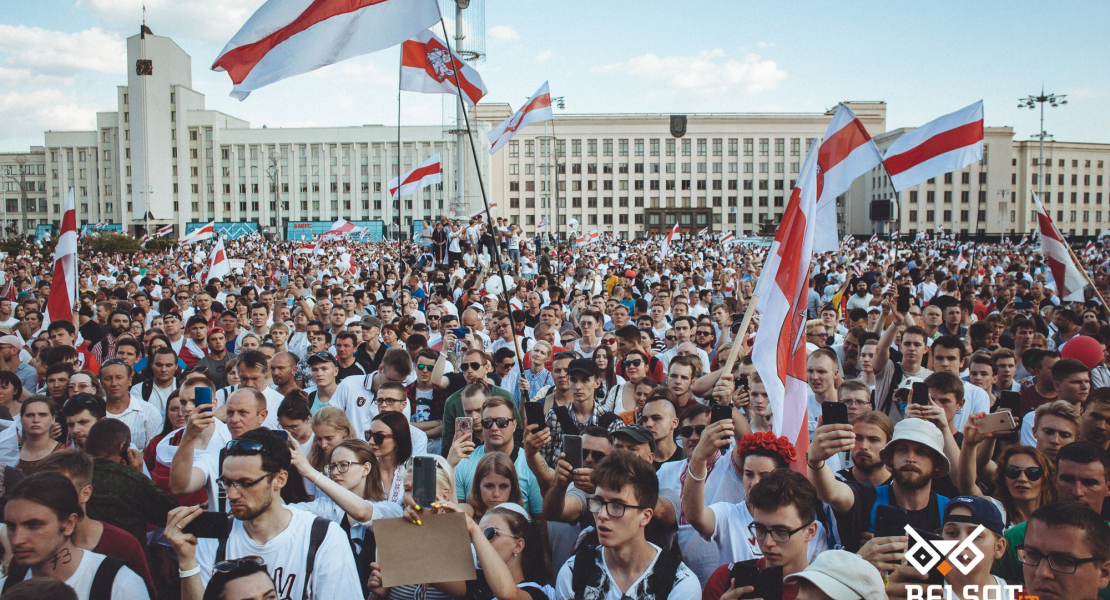photo: Belsat
Change in public opinion is irreversible.
On 14 August on Independence Square in the Belarusian capital Minsk, for the first time in 10 years, a rally of thousands of opponents of the authorities took place. And for the first time during the regime of President Alexander Lukashenka, a rally at this location was held without the arrest of peaceful demonstrators.
This became possible thanks to an irreversible change in public opinion which has occurred following fatal mistakes by the authorities during the electoral campaign of 2020: they inadequately assessed the threat of protests, and applied a combination of responses to those protests in the wrong proportions.
The wrong combination of sticks and carrots
In theory, any authoritarian regime has three options when facing peaceful protests:
- ignore them and wait for the mobilisation to die down;
- meet the protesters’ demands;
- use force to intimidate people and bring the protests to an end.
In practice, an authoritarian regime can combine these options, and that is exactly what the Belarusian regime tried to do on 9-14 August.
But the problem (for the regime) is that they combined these options incorrectly. The harsh suppression of peaceful protests on 9-11 August was not harsh enough to prevent street activity emerging in the days following. At the same time, the horrific violence meted out by the security forces’ angered Belarusian society to the point that it turned people against the authorities, including those who until then had not taken an active position on the election or post-election protests.
The Ministry of Internal Affairs claims 7,000 people have been detained, but eyewitnesses say that prison cells are overcrowded tenfold, and the number of victims of police violence is much higher. Human rights activists note the widespread use of torture and ill-treatment of detainees, including severe beatings and rape.

Protest near KGB headquarters in Minsk. Photo: RFE/RL
On 13-14 August, the authorities chose a wait-and-see tactic, mostly allowing the protests to develop on their own. However, adopting this approach after the wave of violence that had shocked society did not lead to the demobilisation of society and the petering out of protests. On the contrary, more and more people used the window of opportunity for peaceful protest to demonstrate their solidarity with the victims of repression and demand free and fair elections. This culminated in the peaceful march of tractor plant workers and women with flowers to the Government House on 14 August.
Strikes and workers’ demonstrations demanding free elections have taken place not only at the Minsk Tractor Plant but at dozens of state and private enterprises throughout the country, including Belaruskali, BelAZ, Belarusian Nuclear Power Plant, MAZ, Belarusian Metallurgical Plant, Grodno-Azot and others.
Finally, on 12-14 August, the authorities tried to use carrots. They turned on the internet, released many detained people, and engaged in dialogue with journalists and residents of regional, single-industry towns. However, the main demand of all protesters – free and fair elections – cannot be fulfilled by the authorities, since in the current situation this is tantamount to the resignation of Lukashenka. For the protesters, any compromise without securing this point is tantamount to the defeat of the protest movement.
The Belarusian authorities have failed to show consistency in any of their responses to the problem facing them, and have alternated these responses in the wrong proportions. In particular, they first angered people with violence and then allowed the protests to develop spontaneously.
Inadequate assessment of threats
Lukashenka for 26 years successfully suppressed political dissent and competition and controlled public sentiment. However, this means that while he has vast political experience, he is also highly dependent on old approaches, lacks a fresh outlook, and perceives what is happening through the lens of his own propaganda.
The protests have been attended by tens of thousands of people all over the country – from Minsk to villages. The protest movement is decentralised. People are forming chains of solidarity in their dormitories and even in their yards. Thus, the exact number of participants at all the protest actions cannot be established.

Workers of Hrodna-Azot and other citizens attend a peaceful rally in Hrodna. Photo: RFE/RL
Following the elections, Lukashenka and the state media preferred to ignore what was happening in the country and to behave as if nothing had happened. The only real effect of this policy has been the rapid growth in Belarusians using the Telegram messaging application and, in particular, following Nexta channels, run by the country’s most popular political blogger, with over 1.5m subscribers.
On 14 August, Lukashenka nevertheless began to comment on what was happening (in the face of rumours that he was not even in the country). However, his clumsy statement that only 20 people were participating in the workers’ strike simply provoked tractor plant workers to put together a banner stating “There are not 20 of us, but 16,000.”
The authorities cannot or do not want to acknowledge the scope of the strikes, and are also ignoring their political nature, speaking out against them on the basis of economic consequences.
Irreversible change in public opinion
Regardless of how the current street protests end, irreversible changes have taken place in Belarusian society, which will affect the future of the country as well as historical attitudes towards the Lukashenka regime.
First, supporters of changes in Belarusian society have firmly recognised themselves as the majority. Despite differences in views and aspirations, people united around election candidate Sviatlana Tsikhanouskaya as a symbol of change. In the future, this camp will inevitably face a split. But at the moment, the political emptiness of Tsikhanouskaya has allowed everyone to project onto her the political images that he or she was looking for.

A memorial event is held at the place the first death of a protester in Minsk took place. Photo: RFE/RL
Secondly, on 9-12 August, the authorities stained themselves when they allowed the security forces to use uncontrolled violence against the general population, including bystanders, women and children. For the first time, a participant in a peaceful protest in Belarus was killed (at least one). The repressions themselves were not new, but their scale and escalation (for example, previously, flashbang grenades and rubber bullets had never used) coincided with the politicisation and mobilisation of people. Most people had no experience of political activities and had never faced police violence. Safety has always been one of the cornerstones of the Lukashenka regime, and in August 2020, the regime itself destroyed this pillar.
Source: Belarus Digest


